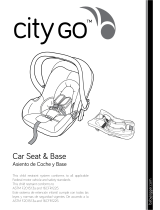
6 PIPA instructions 7PIPA instructions
WARNING
Failure to follow these warnings, instructions
and labels on the child restraint could result
in serious injury or death.
A child’s safety is your responsibility.
NEVER leave your child unattended.
Read all instructions before use of this
child restraint or installation in a vehicle.
In addition, read the vehicle owner’s
manual for information on child restraint
installation.
Use the bottom of the base for storage of
the instruction manual.
Register your child restraint with the
manufacturer.
This child restraint can ONLY be used in a
rear facing position when using in a vehicle.
The child restraint cannot be properly
secured in a forward facing position, and
will be unsafe. Use only with children who
weigh between 4 and 32 pounds (2 and
14.5 kg) and whose height is 32 inches (81
cm) or less. Exceeding these height and
weight limits is unsafe.
Cover the child restraint when your vehicle
is parked in sunlight. Parts of a child
restraint can become very hot if left in the
sun, and can burn a child’s skin. Check for
hot parts before putting your child in the
child restraint.
Secure this child restraint with the vehicle’s
child restraint anchorage system if
available, or with a vehicle belt.
Replace this child restraint if it has been
involved in a crash, even if it was minor and
there appears to be no damage to the child
restraint.
Snugly adjust the belts provided with
this child restraint around your child. If
straps are not snugly adjusted, child may
be ejected from seat in the event of an
accident.
A snug strap should not allow any slack.
It lies in a relatively straight line without
sagging. It does not press on the child’s
flesh or push the child’s body into an
unnatural position.
EXPIRATION DATE Check the label on the
underside of the base or child restraint for
expiration date information.
FALL HAZARD Child’s activity can move
carrier. NEVER place carrier on counter
tops, tables, or any other elevated surface.
Always stay within arm’s reach whenever
carrier is not on floor/ground. Be sure
handle locks into position before lifting
carrier.
STRANGULATION HAZARD Children
have strangled in loose or partially buckled
harness straps. Fully restrain the child even
when carrier is used outside the vehicle.
SUFFOCATION HAZARD Infant carrier can
roll over on soft surfaces and suffocate
child. Never place carrier on beds, sofas, or
other soft surfaces.
ALWAYS check child restraint to base
connection.




















